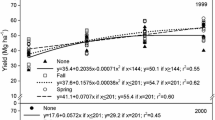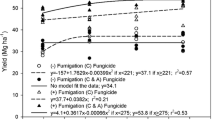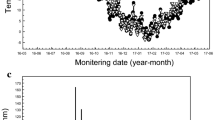Abstract
Residues of 2,4-dichlorophenoxyacetic acid (2,4-D) in potato tubers from plants sprayed with a total of 140 g acid equivalent 2,4-D per hectare ranged from 51 to 152 parts per billion (ppb) in samples collected in research plots during a three year period. Comparable samples collected in commercial fields ranged from 84 to 224 ppb in 1975. Higher application rates of 2,4-D to potatoes resulted in slightly higher residues in tubers. Differences in 2,4-D residues among three cultivars were not significant. There was a decrease in 2,4-D residues between the second and sixth week following the last 2,4-D spray application, primarily because 2,4-D was diluted by additional tuber growth. Following harvest, 2,4-D residues decreased, while residues of 2,4-dichlorophenol (2,4-DCP) remained essentially stable in fresh stored tubers. Residues of 2,4-D and 2,4-DCP were found both in the peel and peeled parts of the tuber in approximately equal concentrations. Baking did not reduce the concentrations of residues of 2,4-D and 2,4-DCP.
Resumen
Residuos del ácido 2,4-Diclorofenoxiacético (2,4-D) en tubérculos de papa de plantas asperjadas en un total de 140 g de ácido equivalente 2,4-D por hectárea estuvieron entre 51 y 152 partes por billón (ppb) en muestras colectadas de parcelas de investigación durante un período de tres años. Muestras comparativas colectadas en campos comerciales, estuvieron entre 84 y 224 ppb in 1975. Dosis más altas de aplicación de 2,4-D en papas resultaron en un ligero aumento de residuos en tubérculos. Las diferencias de residuos de 2,4-D entre tres cultivares no fué significativa. Hubo una diseminación de residuos de 2,4-D entre la segunda y sexta semana siguientes a la última aplicación de 2,4-D mayormente debido a la dilución del 2,4-D por crecimiento adicional del tubércule Luego de la cosecha disminuyeron los residuos del 2,4-D mientras que los residuos del 2,4-Diclorofenol (2,4-DCP) se mantuvieron esencialmente estables en tubérculos almacenados frescos. Residuos de 2,4-D y 2,4-DCP fueron encontrados tanto en la cáscara como en las partes peladas del tubérculo en concentraciones aproximadamente iguales. El horneado no redujo la concentración de residuos de 2,4-D y 2,4-DCP.
Similar content being viewed by others
Literature Cited
Nelson, D.C. and R.E. Nylund. 1963. Influence of 2,4-D on uniformity and specific gravity of potatoes. Am Potato J 40:391–395.
Nylund, R.E. 1956. The use of 2,4-D to intensify the skin color of Pontiac potatoes. Am Potato J 33:145–154.
Wort, D.J. 1962. The application of sublethal concentrations of 2,4-D alone, and in combination with mineral nutrients. World Rev Pest Control 1:6–19.
Wort, D.J. 1965. Increased tuber yield of Pontiac potatoes resulting from the foliar application 2,4-D mineral dusts. Am Potato J 42:90–96.
Author information
Authors and Affiliations
Additional information
Published with the approval of the Director of the North Dakota Agricultural Experiment Station as Journal Article No. 1047.
Formerly Associate Professor, Department of Biochemistry, North Dakota State University
Rights and permissions
About this article
Cite this article
Bristol, D.W., Nelson, D.C. & Cook, L.W. Residues and dissipation of 2,4-D and 2,4-DCP in potato tubers. American Potato Journal 58, 143–151 (1981). https://doi.org/10.1007/BF02854413
Received:
Issue Date:
DOI: https://doi.org/10.1007/BF02854413




